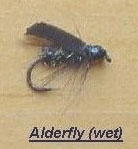Awesome Alder Flies
By Joe Bertolaccini
When fishing slow moving streams and ponds, I have frequently seen a black caddis like fly hatching from the shorelines. I was not aware that there was any such thing as a black caddis but what I found in reality was that I was looking at adult alderflies. In their life cycle, the adult is perhaps the most important stage to the angler. They deposit their eggs in overhanging stream or lakeside vegetation and when hatched, the larvae fall to the  water surface where they live predominantly in the bottom debris of sluggish streams and pond. Subsequently they crawl on land to burrow in silt and rotten logs where they pupate and hatch in late spring. Once hatched, the adults are very awkward fliers and land on water only by chance where they struggle and begin to sink.
water surface where they live predominantly in the bottom debris of sluggish streams and pond. Subsequently they crawl on land to burrow in silt and rotten logs where they pupate and hatch in late spring. Once hatched, the adults are very awkward fliers and land on water only by chance where they struggle and begin to sink.
This is the time when they are most susceptible to fish. Alderflies and caddis flies both have the same tent-shaped wings, short bodies and long antennae, the major difference being that caddis flies have hairy wings as opposed to the rather smooth wings of the alderfly. The latter varies in length but can best be imitated on sizes 10 to14 standard dry fly hooks. Coloration is dark gray to black. It is not necessary to apply dry fly flotant to this pattern because of the tendency for the natural to sink. The following dry fly version that I’ve had success with has only a black ostrich herl body and a wing of dyed black elk or deer hair. Other wing materials can include black Z-lon, Antron yarn or black CDC feather. Body materials can be dubbed black fur, peacock herl, or clipped black hackle.
Adult Alderfly (dry)
Hook – Standard dry fly, size 10 to 14.
Thread – Black 6/0.
Body – Black ostrich herl wound in tight wraps around the hook shank.
Wing – Black elk hair, tied as in the elk hair caddis.
Head – Black thread.
Following is the dressing for a wet fly imitation created by Dave Hughes, a nationally known angler and fly tyer, and described in his excellent book, “Handbook of Hatches” published in 1987.
Adult Alder Fly (wet)
Hook – Standard wet fly, size 10 to 14.
Thread – Black 6/0.
Rib – Gold wire.
Body – Peacock herl.
Collar – Sparse black hen hackle.
Wing – Dark turkey quill.
Head – Black thread.
Dave goes on to say that “the alderfly characteristic of sinking almost immediately on contact with the water makes the wet fly a more effective dressing than the dry. PresenJoe has enjoyed fly fishing for over 65 years. His first book, Fundamentals of Fly Fishing, is now available. He can be reached at: [email protected] tation is based upon the struggling of the natural, which truly results in little but internal motion, and no forward motion. In lakes the fly should be fished on a long leader and floating line. After sinking a few inches, it should be retrieved back with short twitches of the rod tip. The retrieve should be slow, with frequent pauses to let the fly settle.”
Joe Bertolaccini has enjoyed fly fishing for over 65 years. His first book, Fundamentals of Fly Fishing, is now available. He can be reached at: [email protected]
For more articles and stories about hunting, fishing and the outdoors, be sure to subscribe to our monthly publication the Northwoods Sporting Journal.
To access past copies of the Northwoods Sporting Journal in digital format at no charge, click here.
